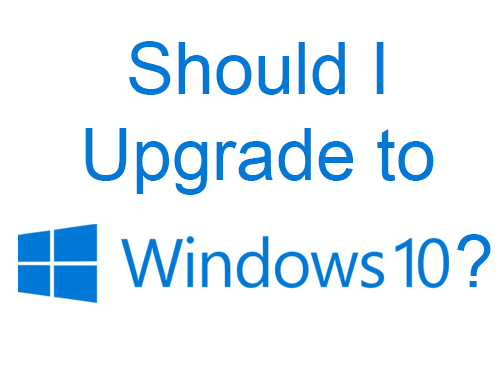
If you’re a personal computer (P.C.) user, this isn’t your first rodeo. I started this often frustrating journey of updating operating systems with Microsoft Windows 95. From there, I’ve experienced the joys of Windows 98, Millenium Edition (ME), XP, Vista, 7, 8, and countless versions of Microsoft Windows Server in my professional life. I’ve been through upgrades, reformats, new installs, the gamut. Whether this trail of Windows leaves me a glutton for punishment, or just old, is left to you, the reader, to decide. A new contender for tearing your hair out has emerged: Windows 10. If you currently use a Windows 7 or 8 computer, chances are an inviting message urging you to upgrade to Windows 10 has appeared on your screen for the last two months. Microsoft even sweetened the deal by giving it to you for free. But, should you bite the bullet and click “Get your free upgrade”? Let’s investigate.
If you’ve had any experience with Windows 8, you know just how different it is than any operating system that’s come before it. Microsoft’s intention was to build a platform that could work across all devices, from computers, to tablets, to smartphones, to Xbox. It introduced apps or tiles as they’re called to the P.C. This worked very well with everything but a P.C.! If you had a touchscreen laptop it worked pretty well. Anyway, the biggest gripe many had with Windows 8 was that the “Start” button that has been in place since the aforementioned Windows 95 was gone. Microsoft eventually relented and released a major upgrade (called 8.1) to include it. Unfortunately for them, many decided to avoid Windows 8 like the plague and stick to Windows 7 because it was so different. They faced the same backlash after releasing a flawed Windows Vista. Windows 7 is actually a “fixed” Windows Vista. I bet you can guess what the solution was: create a new operating system that’s essentially a hybrid of Windows 7 and Windows 8 and call it Windows 10. Perfect!
So, what are the pros and cons to installing Windows 10? Well, it’s free for one. From the end of July 2015 you have one year to redeem your free upgrade if you’re using Windows 7 or Windows 8.1. After that, you’d have to pony up. If you’re on XP or Vista, you’d have to upgrade your equipment to run 10 successfully, hence, the lack of a free upgrade. Another plus: Cortana. If you own an Apple product, you’re familiar with the personal assistant, Siri. Microsoft introduces it’s own version, Cortana, who can recognize voice commands, complete Internet searches, take notes, schedule appointments, change settings, and get driving directions. A cool new feature of Windows 10 is the ability to create multiple workspaces – in other words, to work as if you’re using multiple monitors. Windows will split your screen in half or into quarters to ease in multi-tasking. Also, Windows 10 includes a new web browser called Edge. It’s faster and more robust than the tried and true Internet Explorer.
There are cons, however. The biggest thing to consider anytime you’re thinking of upgrading is the age of software and hardware you’re using. There’s no guarantee that older programs, or devices such as printers and scanners will be compatible with Windows 10. Most current products won’t be a problem, but if there are any questions, try to verify that they will work before taking the plunge. A major negative to me is the Windows Update process. If you’re currently on the “Home” version of Windows 7 or 8, you’ll be upgraded to Windows 10 Home. Because of this, in their infinite wisdom, Microsoft has decided that all major Windows Updates will be downloaded and installed automatically by default. I don’t know about you, but I don’t like things being forced on me. The worst part of all, is that if the computer needs to be restarted to complete the updates, the default setting is for the computer to be restarted when it’s idle. Say you’re working on a document that hasn’t been saved in a while, and the doorbell rings. You step away from the computer for a few minutes, and guess, what, the computer has restarted. Not a good situation. Also, I mentioned the Edge browser earlier as a pro. The con to Edge is that if you have a series of “Favorites” you’ve saved from Internet Explorer, these Favorites won’t show up in Edge. The good news is that although Edge is the default browser in Windows 10, Internet Explorer is included (though hidden) in the upgrade so you can transfer your Favorites to Edge, or stick to the old standby.
The bottom line is that this release of Windows 10 is effectively a beta or work in progress. Personally, I’m waiting six months or so to let others work the kinks out of the operating system before I jump on board. Microsoft will be monitoring the process and making updates and changes as needed. If you do decide to upgrade and have problems or find it less than satisfactory, you have thirty days to return to your previous operating system. No files will be lost in either an upgrade or downgrade, but PLEASE consider backing up your personal files before doing so just in case. Click here for more information on doing this. Windows 10 has a lot of potential, and when the time is right, grab your free upgrade!
